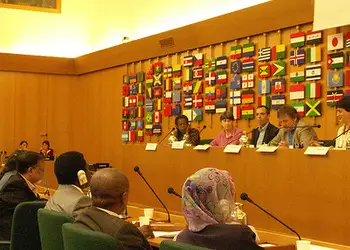web2fordev conference impressions (2)
Complexity
Another key lesson was the big question of 'how to best combine all these web2.0 tools to obtain better results.' Everybody is still experimenting --this might be what web2.0 is all about. Nevertheless, I understood the importance of taking a holistic approach and use a combination of blogs according to the objective. So,  experimenting still needs a strategic approach; in that way users do not fear an information overload. Blogs, for example, can be used for knowledge sharing, but then they may need to be very different when used for a campaign. And how are wikis and blogs linked to preserve transparency? I did not hear about strategies for best combining all the tools using available data and rss feeds. How do I offer all these channels for collaboration and still filter what is important to me? This has to be overcome to prove the benefit and not just use the technology for the sake of it.
experimenting still needs a strategic approach; in that way users do not fear an information overload. Blogs, for example, can be used for knowledge sharing, but then they may need to be very different when used for a campaign. And how are wikis and blogs linked to preserve transparency? I did not hear about strategies for best combining all the tools using available data and rss feeds. How do I offer all these channels for collaboration and still filter what is important to me? This has to be overcome to prove the benefit and not just use the technology for the sake of it.
I had the feeling everybody shared an enthusiasm for the potential that development can have, but I also only saw a few clear structured projects. A complete contrast to that was Damir Simunic, who talked about Collaboration on the Edge of Network. He basically argued that web2.0 is still too far away from broad usage by presenting a tool relying solely on emails, which has enough capabilities. Even though I find email is often an information overload application, Damir gave an interesting example: at the WHO, a 20.000 people network manages over easy mailing lists and easy features, proving traditional ways can be successful, especially in developing countries.
Networks Dan McQuillan wrote a powerful wake up post and summarized very good the strategic questions about 'dealing now with the available possibilities through web2.0.' To me, it seems the power of web2.0 has been shared by most participants, but what could be done with it now and how to engage it was still unclear. In my panel, I asked therefore, whether organizations are open to sharing, willing to network and engage in such a participative manner. The conference showed how web2.0 brings an unusual mixture of individuals (e.g. activists), organizations, media and companies together. It needs a change in culture towards more openness and trust, which is not always easy --after all, who wants to or can accept that his or her wiki text has suddenly changed? Collaboration through web2.0 is happening between a diversified landscape of these actors, and I wonder what will be the outcome of that. I liked the way Dan quotes Charles Leadbeater on 'low-cost, self-organising networks will innovate all kinds of needed solutions.' I hope that this innovation will be open source driven.
Content Interestingly, there were few discussions about content. **What is the type of content that will be delivered, shared and remixed through web2.0? **What kind of content is there and how can it be virtually exchanged in a rather oral culture? Moses Kisembo and Jon Corbett summarized it nicely in a discussion we had. What helps all these new forms of information and technology when one does not know how to use them, and then it does not have any benefit, e.g. for a farmer? The question of relevance of all this user generated content was rarely discussed. Ethan Zuckermann emphasized in his presentation how important filters in this regard are. **How to filter the information or voices to a meaningful size to find all that that is important to me. **Aggregators can help, and so do social bookmarking sites, which show evaluated ranked webistes. More important are however, people, who sort, comment and translate content and make sense and relevance in the growing sea of information.
However, I imagine too that feeds and tagging can help. And as fast as the web developed, more things are coming up such as rss manipulation. That means, you drag data from different sources and with the sum of it, you make something better. And that is also what Michael Saunby's presentation showed. With a mix of rss and data, manipulation fascinating new geographical information can be generated. These mashups can be mixed with all kind of freely available information sources, and as with Michael Saunby's case, allow individual climate change analysis.